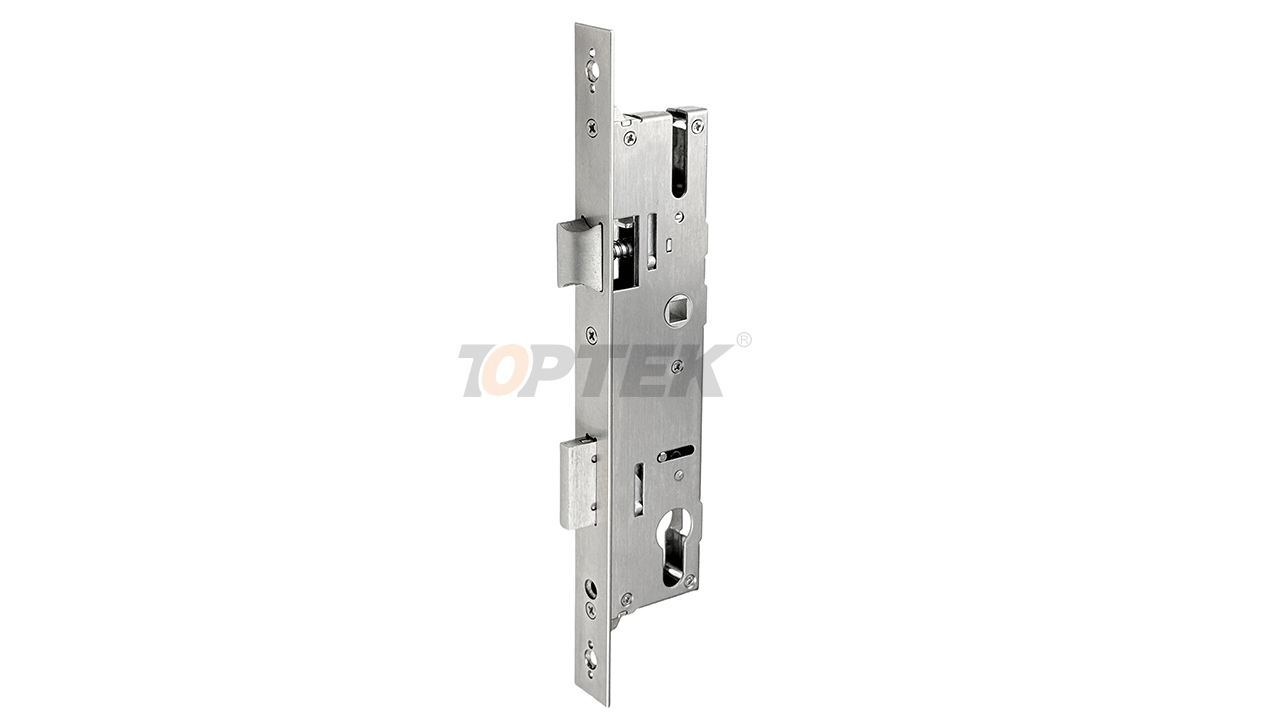Fire doors are a critical part of a building's passive fire protection system. Their primary job is to slow the spread of fire and smoke, giving occupants crucial time to evacuate safely. This function often leads to a common and important question: can a fire door be locked? The answer is yes, but it comes with strict rules and regulations. Locking a fire door incorrectly can have catastrophic consequences, turning a life-saving feature into a dangerous obstacle.
Understanding the correct way to secure a fire door is not just a matter of safety; it's a legal requirement. Non-compliance can lead to severe penalties, including hefty fines and even imprisonment in the event of a fire-related incident. This guide will explain the regulations surrounding fire door locks, explore the types of compliant hardware, and provide the essential information you need to ensure your building is both secure and safe.
We will cover why certain locks are prohibited, what makes a fire door lock compliant, and how to choose the right hardware for your specific needs. By the end, you'll have a clear understanding of how to balance security with the absolute necessity of a clear escape route.
Why Standard Locks Are Prohibited on Fire Doors
The core principle of a fire door on an escape route is that anyone can open it from the inside without needing a key, special knowledge, or excessive force. This is why standard deadbolts, key-operated locks, or any device that impedes a swift exit are strictly forbidden.
During an emergency, panic and confusion can set in quickly. Smoke can reduce visibility, and power outages can plunge an area into darkness. In these conditions, fumbling for a key or trying to figure out a complex lock is not just an inconvenience—it's a life-threatening delay. Fire regulations are designed with this worst-case scenario in mind. Any lock that requires a key or tool for egress effectively traps people inside, directly violating fire safety codes like the NFPA 80 standard.
These regulations exist to ensure that a fire escape route remains functional at all times. Even a simple slide bolt or a manually operated deadbolt can create a fatal obstruction. For a fire door to do its job, it must be easily and immediately operable by anyone trying to escape.
The Essentials of a Compliant Fire Door Lock
For a lock to be suitable for a fire door, it must meet several key criteria. These requirements ensure the door remains an effective fire barrier while allowing for safe and rapid evacuation.
1. Fire-Rated Hardware
The most important requirement is that the lock itself must be fire-rated. This means it has been tested and certified to withstand fire for a specific duration (e.g., 30, 60, 90, or 120 minutes), matching the rating of the fire door it's installed on. A fire-rated lock, often marked with a CE or UL symbol, will not melt or fail when exposed to high temperatures, preventing the door from warping or opening prematurely and allowing fire to spread. Using a non-rated lock on a fire door voids the door's certification and compromises the entire fire compartment.
2. Single-Action Egress
A compliant fire door lock must allow the door to be opened from the inside with a single, simple action. This is the "panic-proof" principle. Occupants should not have to perform multiple steps, like turning a knob and then a key, to open the door. A simple push or pull on a lever or bar should be sufficient to unlatch the door and allow for escape.
3. Self-Latching Mechanism
Fire doors must be self-closing and self-latching. This means that after someone passes through, the door must swing shut and securely latch on its own. This is crucial for maintaining the integrity of the fire barrier. A fire door that is left ajar is useless. The lock's latching mechanism must engage automatically every time the door closes, ensuring it forms a seal against fire and smoke.

Types of Compliant Fire Door Locks
Several types of locking hardware are designed specifically to meet fire safety regulations. Choosing the right one depends on the building's use, traffic levels, and security needs.
Panic Bars (Push Bars)
Also known as exit devices or crash bars, panic bars are the most common and recognizable type of fire door hardware. They consist of a spring-loaded metal bar fixed horizontally to the inside of the door. Pushing on the bar—even with body weight during a panic-driven rush—retracts the latch, allowing the door to open. They are ideal for high-traffic areas and public buildings like schools, theaters, and hospitals, where large numbers of people may need to evacuate quickly.
Emergency Push Pads
Similar to panic bars, push pads are smaller devices that unlatch the door when pressed. They are suitable for buildings with fewer occupants who are familiar with the escape routes, such as offices or small commercial spaces. Like panic bars, they allow for single-action egress but are less obtrusive.
Fire-Rated Mortice Locks
A mortice lock can be used on a fire door, provided it is fire-rated and equipped with the correct hardware. The key difference is how it operates from the inside. For compliance, a fire-rated mortice lock must be paired with a lever handle that operates the latch. The lock can be locked from the outside with a key to provide security, but from the inside, a simple downward push on the lever handle must be all that is needed to open the door. The key-locking function must never override the lever handle's ability to retract the latch from the inside.
Access Control Systems
Modern buildings often use electronic access control systems with magnetic locks (maglocks) or electric strikes. These can be used on fire doors if they are correctly integrated with the building's fire alarm system. In the event of a fire alarm or power failure, the system must automatically release the lock, allowing the door to be opened freely. This is known as "fail-safe" operation. Any such system must be properly certified and installed to meet fire codes.
Balancing Safety and Security
The need for security is undeniable, but on a fire escape route, life safety must always take precedence. The regulations governing fire door locks are not designed to be inconvenient; they are the result of lessons learned from tragic incidents where locked or blocked exits led to preventable deaths.
By selecting and correctly installing compliant, fire-rated hardware, building owners and managers can ensure their property is secure against unauthorized entry while guaranteeing that occupants have a clear and unobstructed path to safety during an emergency. Regular maintenance and inspections of fire doors and their locks are also a legal requirement to ensure they remain in perfect working order.
Your Next Steps for Compliance
Ensuring your building's fire doors are compliant isn't just a box-ticking exercise—it's a fundamental responsibility. If you are unsure whether your fire door locks meet current safety standards, it is crucial to seek professional advice.
Consult with a certified fire safety expert or a specialist in fire door installation and maintenance. They can assess your current hardware, identify any non-compliant features, and recommend the appropriate solutions to make your building safe, secure, and legally compliant. Don't leave it to chance; the safety of everyone in your building depends on it.
Fire Door Lock
CE Mortice Lock
Euro Mortice Lock
English
العربية
Français
Русский
Español
Português
Deutsch
italiano
日本語
한국어
Nederlands
Tiếng Việt
ไทย
Polski
Türkçe
አማርኛ
ພາສາລາວ
ភាសាខ្មែរ
Bahasa Melayu
ဗမာစာ
தமிழ்
Filipino
Bahasa Indonesia
magyar
Română
Čeština
Монгол
қазақ
Српски
हिन्दी
فارسی
Kiswahili
Slovenčina
Slovenščina
Norsk
Svenska
українська
Ελληνικά
Suomi
Հայերեն
עברית
Latine
Dansk
اردو
Shqip
বাংলা
Hrvatski
Afrikaans
Gaeilge
Eesti keel
Māori
සිංහල
नेपाली
Oʻzbekcha
latviešu
অসমীয়া
Aymara
Azərbaycan dili
Bamanankan
Euskara
Беларуская мова
भोजपुरी
Bosanski
Български
Català
Cebuano
Corsu
ދިވެހި
डोग्रिड ने दी
Esperanto
Eʋegbe
Frysk
Galego
ქართული
guarani
ગુજરાતી
Kreyòl ayisyen
Hausa
ʻŌlelo Hawaiʻi
Hmoob
íslenska
Igbo
Ilocano
Basa Jawa
ಕನ್ನಡ
Kinyarwanda
गोंगेन हें नांव
Krio we dɛn kɔl Krio
Kurdî
Kurdî
Кыргызча
Lingala
Lietuvių
Oluganda
Lëtzebuergesch
Македонски
मैथिली
Malagasy
മലയാളം
Malti
मराठी
ꯃꯦꯇꯥꯏ (ꯃꯅꯤꯄꯨꯔꯤ) ꯴.
Mizo tawng
Chichewa
ଓଡ଼ିଆ
Afaan Oromoo
پښتو
ਪੰਜਾਬੀ
Runasimi
Gagana Samoa
संस्कृत
Gaelo Albannach
Sepeti
Sesotho
chiShona
سنڌي
Soomaali
Basa Sunda
Wikang Tagalog
Тоҷикӣ
Татарча
తెలుగు
ትግንያውያን
Xitsonga
Türkmençe
संस्कृत
ئۇيغۇرچە
Cymraeg
isiXhosa
ייִדיש
Yorùbá
isiZulu





































